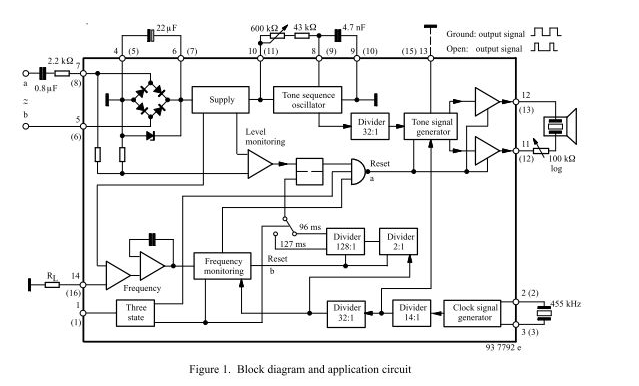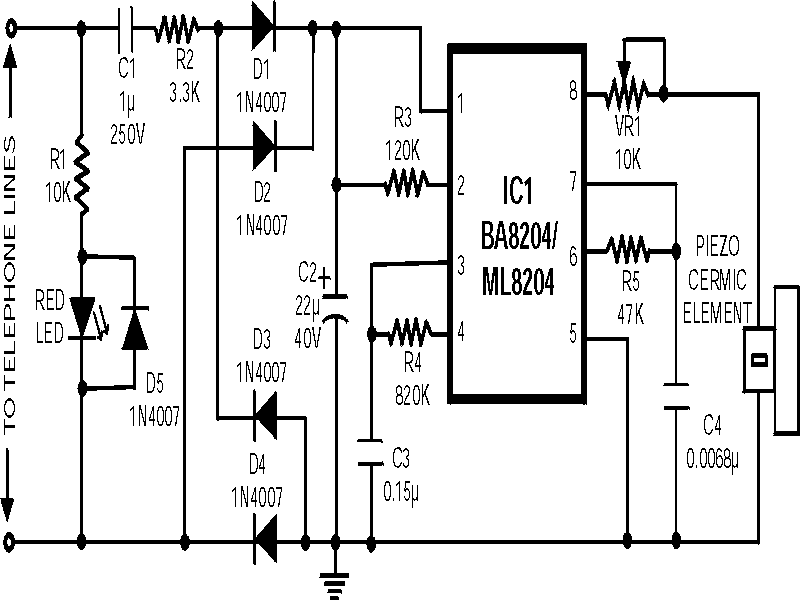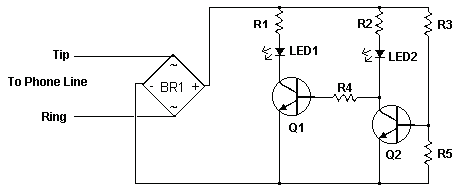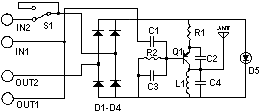
U4076B Three-tone Ringer Telephone Sets

The three-tone ringing integrated circuit U4076B, in conjunction with a piezo transducer or loudspeaker, replaces the normal electromechanical telephone bell. It is operated with the ringing current frequency.
The U4076B integrated circuit is designed to generate a three-tone ringing signal, which can effectively replace traditional electromechanical bells found in telecommunication devices. This circuit is particularly advantageous in applications where space and energy efficiency are critical. The U4076B operates by producing a sequence of three distinct tones that create an appealing auditory signal, enhancing the user experience compared to a single-tone bell.
The circuit requires a power supply that is compatible with the ringing current frequency, typically in the range of 20 Hz to 50 Hz, depending on the specific application and regional standards. The piezo transducer or loudspeaker connected to the U4076B is responsible for converting the electrical signals generated by the IC into audible sound. The choice of transducer can significantly affect the volume and quality of the ringing sound produced.
In terms of circuit design, the U4076B typically interfaces with a minimal number of external components, including resistors and capacitors, to set the tone frequencies and control the output signal. The output stage of the circuit may include a driver transistor to ensure sufficient power is supplied to the transducer for clear sound reproduction. The implementation of this integrated circuit allows for a compact and reliable solution for modern telephone systems, making it an excellent choice for both consumer and commercial applications.
Overall, the U4076B integrated circuit represents a significant advancement in ringing signal technology, providing a versatile and efficient alternative to traditional bell systems.The three-tone ringing integrated circuit U4076B in conjunction with a piezo transducer or loudspeaker replaces the normal electromechanical telephone bell. It is operated with the ringing current fr.. 🔗 External reference
The U4076B integrated circuit is designed to generate a three-tone ringing signal, which can effectively replace traditional electromechanical bells found in telecommunication devices. This circuit is particularly advantageous in applications where space and energy efficiency are critical. The U4076B operates by producing a sequence of three distinct tones that create an appealing auditory signal, enhancing the user experience compared to a single-tone bell.
The circuit requires a power supply that is compatible with the ringing current frequency, typically in the range of 20 Hz to 50 Hz, depending on the specific application and regional standards. The piezo transducer or loudspeaker connected to the U4076B is responsible for converting the electrical signals generated by the IC into audible sound. The choice of transducer can significantly affect the volume and quality of the ringing sound produced.
In terms of circuit design, the U4076B typically interfaces with a minimal number of external components, including resistors and capacitors, to set the tone frequencies and control the output signal. The output stage of the circuit may include a driver transistor to ensure sufficient power is supplied to the transducer for clear sound reproduction. The implementation of this integrated circuit allows for a compact and reliable solution for modern telephone systems, making it an excellent choice for both consumer and commercial applications.
Overall, the U4076B integrated circuit represents a significant advancement in ringing signal technology, providing a versatile and efficient alternative to traditional bell systems.The three-tone ringing integrated circuit U4076B in conjunction with a piezo transducer or loudspeaker replaces the normal electromechanical telephone bell. It is operated with the ringing current fr.. 🔗 External reference





